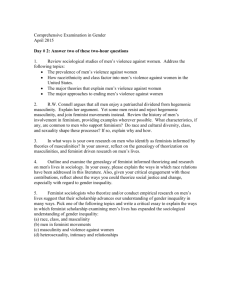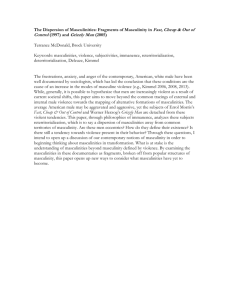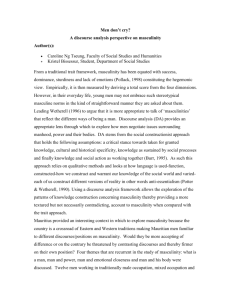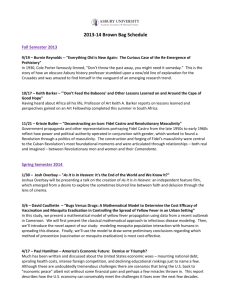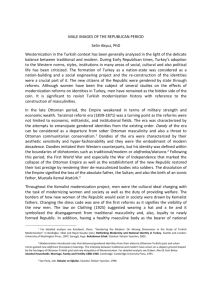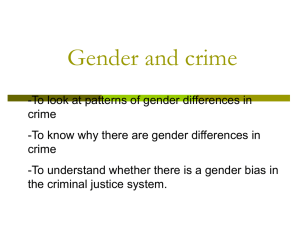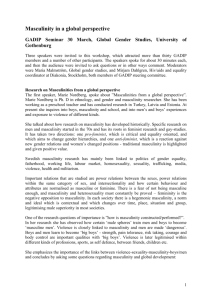Connell_epidemic
advertisement
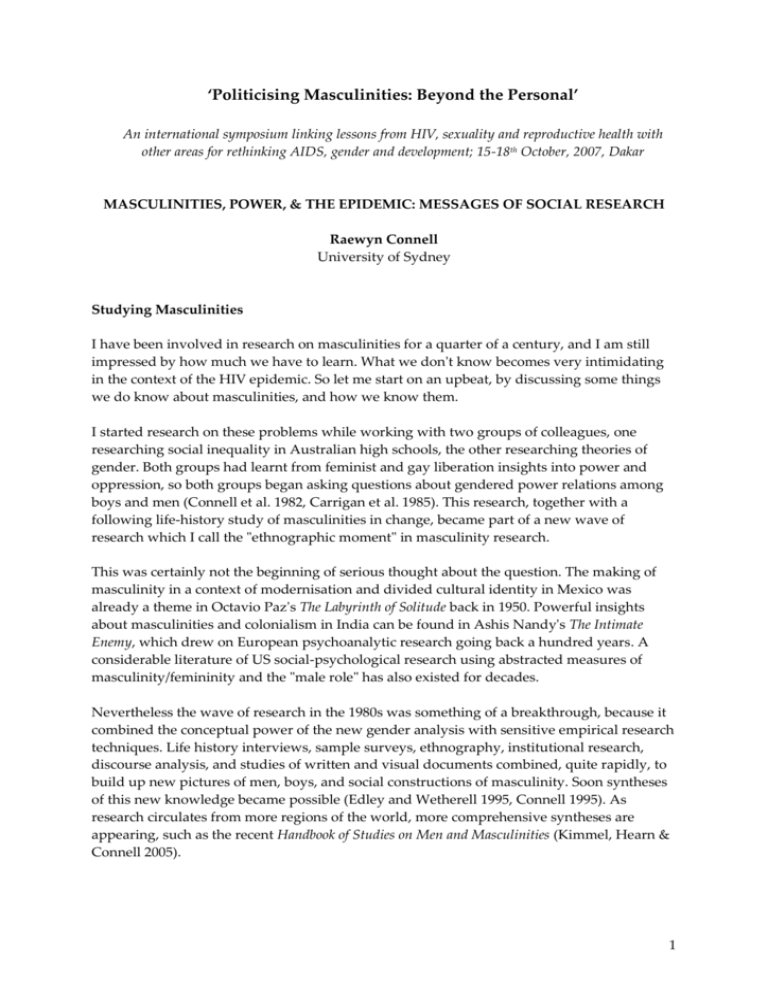
‘Politicising Masculinities: Beyond the Personal’ An international symposium linking lessons from HIV, sexuality and reproductive health with other areas for rethinking AIDS, gender and development; 15-18th October, 2007, Dakar MASCULINITIES, POWER, & THE EPIDEMIC: MESSAGES OF SOCIAL RESEARCH Raewyn Connell University of Sydney Studying Masculinities I have been involved in research on masculinities for a quarter of a century, and I am still impressed by how much we have to learn. What we don't know becomes very intimidating in the context of the HIV epidemic. So let me start on an upbeat, by discussing some things we do know about masculinities, and how we know them. I started research on these problems while working with two groups of colleagues, one researching social inequality in Australian high schools, the other researching theories of gender. Both groups had learnt from feminist and gay liberation insights into power and oppression, so both groups began asking questions about gendered power relations among boys and men (Connell et al. 1982, Carrigan et al. 1985). This research, together with a following life-history study of masculinities in change, became part of a new wave of research which I call the "ethnographic moment" in masculinity research. This was certainly not the beginning of serious thought about the question. The making of masculinity in a context of modernisation and divided cultural identity in Mexico was already a theme in Octavio Paz's The Labyrinth of Solitude back in 1950. Powerful insights about masculinities and colonialism in India can be found in Ashis Nandy's The Intimate Enemy, which drew on European psychoanalytic research going back a hundred years. A considerable literature of US social-psychological research using abstracted measures of masculinity/femininity and the "male role" has also existed for decades. Nevertheless the wave of research in the 1980s was something of a breakthrough, because it combined the conceptual power of the new gender analysis with sensitive empirical research techniques. Life history interviews, sample surveys, ethnography, institutional research, discourse analysis, and studies of written and visual documents combined, quite rapidly, to build up new pictures of men, boys, and social constructions of masculinity. Soon syntheses of this new knowledge became possible (Edley and Wetherell 1995, Connell 1995). As research circulates from more regions of the world, more comprehensive syntheses are appearing, such as the recent Handbook of Studies on Men and Masculinities (Kimmel, Hearn & Connell 2005). 1 The results of this research are relevant to many social issues, including those around HIV/AIDS. We have to be thoughtful, nevertheless, in "applying" the findings. The link between social research and social action is not like the link between physics and engineering. Social research illuminates situations - it does not mechanically determine a universal best practice. A good piece of social research does not generate an answer that we can apply everywhere; but it may raise issues and pose questions that we can ask everywhere. A series of good studies can define trends and suggest generalisations on which we can build in new situations. With this in mind, I will list some findings of the "ethnographic moment" in masculinity research that are well supported by evidence (documentation is in Connell 2000, 2005a). 1. Multiplicity. There is no single version of masculinity that is found everywhere. Constructions of masculinity differ from one culture to another, and from one historical moment to another. This point about cultural differences has been strongly made in relation to Chinese masculinities by Louie (2002) and the general conclusion is supported by a mass of historical and ethnographic evidence. Further, multiple masculinities (defined either as identities or as patterns of practice) are found even within the one culture or organisation. There is now abundant evidence on this point too, for instance from studies of youth, which show multiple paths of development for boys (Connell 2005b). These findings argue powerfully against the idea that a violent, aggressive masculinity is "natural" or biologically fixed. They suggest the importance of gathering local information to inform action on issues involving masculinity. 2. Relations among masculinities. Gender structures, involving relations between women and men, also involve relations among groups of men (and to a more limited extent among women) in the form of linked constructions of masculinity. The links very commonly involve hierarchy and exclusion, in which one (or more) pattern of masculinity is socially dominant and other patterns are dishonoured or marginalised. The term "hegemonic masculinity" is in use to name the socially dominant construction of masculinity in a hierarchical gender order (Connell and Messerschmidt 2005). Such hierarchies often involve homophobia, up to the point of extreme violence, in Australian research on homicide (Tomsen 2002). More broadly, contests for dominance or masculine honour among men are a fruitful source of violence. 3. Collectivity. Patterns of masculinity can be understood at the individual level, but it is important to recognise that they also exist at the level of social collectives. Masculinities can be institutionalised in organisations (e.g. armies, trades, bureaucracies) or informal groups (families, friendship networks), and expressed in shared cultural forms (myths and folklore, mass media, social stereotypes). The collective reality is well demonstrated in organisational ethnographies of schools (Mac an Ghaill 1994) and military organisations (Barrett 1996). 2 This collective reality is an important reason why change in gender practice among men and boys is hard to start simply by persuasion. An individual man may be willing, but the institutional setting, or the peer group culture, pushes in the other direction. 4. Social learning. Masculinities (and femininities) are formed over long periods of life, under complex social influences. Much of the popular discussion of masculinity focuses on the influence of older men (especially fathers), but the research demonstrates that women too are deeply involved in this process - as mothers, relatives, friends, sexual partners, and workmates. The process of forming masculinity is often diffuse and almost unnoticed. But it can become highly organised and intensive, for instance in gender-segregated schools, military training, and gender-segregated sports. 5. Complexity. When we look closely at the construction of masculinity, in case-by-case life history research or in conversation analysis, the internal complexities of gender become apparent. There are often contradictory emotional trends in the one person's life. There can be multiple gender positions in discourse among which a given person can shift. Contradictory demands may impinge on men, for instance to maintain their own prestige and to recognise women's rights. Men may have valuable capacities (for instance, to care for small children) but live in social circumstances that rarely call on these capacities. These complexities may produce flexibility in gender practices, but may also be sources of tension or even violence. For instance some men have difficulty handling their dependence on women, when they also fear femininity and seek to separate themselves from it. 6. Change. When the social construction of gender was first recognised, it began to be discussed in terms of "sex roles" and "norms". This was a useful first step, but we now have to move beyond the idea of "the male role". A focus on compliance with norms misses the way that breaking rules may be the means of constructing masculinity, as shown by Norwegian research on teenagers (Haavind 2003), and a wider literature of criminology. Gender relations are historically dynamic, and the complexity of masculinities indicates tensions that can lead to change. There is now considerable evidence, from historical studies and survey research, that constructions of masculinity do change over time. Economic change, war, generational turnover, and broader cultural shifts, may all be involved. A striking example is given by Hunter's (2004) research in KwaZulu Natal, South Africa, tracing changes in the construction of multiple-partner "isoka" masculinity from the rural pre-colonial economy, through the advent of wage labour and Christianity, to unemployment, neoliberalism and rights discourses, and now fresh changes under the impact of HIV/AIDS. New masculine identities emerge, new gender attitudes become predominant among men. This is, obviously, good news for social action. But gender change is not necessarily benign. The story of post-1990 gender politics in the former Soviet bloc is a sobering reminder that gender relations may shift towards more inequality, or new forms of domination. These six points are, in my view, among the most important findings of recent masculinity research. Their relevance to action around HIV/AIDS, both in prevention and care, has been 3 under discussion for some years (Mane and Aggleton 2001). Clearly we will want more such discussion at this conference. At the same time, I should note limits to the understanding of masculinity produced by the "ethnographic moment". Classical ethnography depended on the existence of a small-scale, tradition-bound, functioning culture. But a colonised society, as Georges Balandier (1955) emphasised, is a society in crisis. And in neocolonial society, or in a society ravaged by civil war, or by military intervention, or by neoliberal structural adjustment programs, or in a mega-city marked by mass poverty and migration, there may be no settled norms to be found. That is what Néstor García Canclini says about Mexico City in Consumers and Citizens (2001). If there is no coherent gender order, we may have to think in new ways about how men and women improvise their gender arrangements and practices, across what kinds of fissures or gaps, and under what kinds of stresses. Margrethe Silberschmidt's (2004) thoughtful discussion of male sexuality, violence and HIV/AIDS in east Africa pictures a gender order disrupted by colonialism and its aftermath, in which men commonly believe they should be heads of household but do not usually have the economic resources to do the job. Masculinity is in question at the most existential level, and the responses to this disruption are often those that sharply increase the risk of HIV infection. But there is another side to this. The world of structural adjustment programs and military interventions is also a world of organised powers. Transnational corporations, global capital markets, multinational agencies, superpower security forces, and international media are key features of the world we live in - as the "globalisation" literature keeps reminding us, in however mythologised a way (Connell 2007). This newly-expanded system of transnational institutions is gendered - in fact, strongly gendered. Among the evidence: transnational corporations' gender-segregated labour forces e.g. in export processing zones; the almost total dominance of men at the top levels of TNC management, military control, the arms trade, and international organisations such as the World Bank; the masculinisation of capital market trading floors and business media; the sexualisation of women in global mass media; the internationalisation of the sex trade; the gender segregation of the international sports industries (Hooper 2001, Connell 2002, Acker 2004). But these institutions need not reproduce exactly the gender patterns that existed anywhere before. There are certainly new large-scale gender divisions of labour (in maquiladoras, transnational mining and timber industries, etc.). There is some evidence of new patterns of managerial masculinity emerging in transnational business (Connell and Wood 2005). In a study of the masculine subjectivities competing in the Cochabamba "water wars" in Bolivia, Nina Laurie (2005) emphasises the incomplete and contestable nature of neoliberal globalisation projects and discourses; new masculine (and feminine) identities are able to appear or old ones to be re-worked. 4 A new research field is opening up here, concerning forms of gender in transnational arenas and the ways they interact with local gender orders. This is, I consider, an important frontier of masculinity research, whose relevance to forward thinking about the epidemic is evident. Some Masculinity Dynamics and the Epidemic In this section I reflect on several connections between HIV/AIDS and current understandings of masculinity. I will start with a group of men who are vitally involved, though as far as I know their prevalence rate is quite low: first-world corporate managers and financiers. Anti-retroviral drugs were sold for years at prices that put them out of the reach of millions of people with HIV infection. The pricing involved decisions by rich men that involved the deaths of large numbers of poor people. Of course, that isn't the way the issue was presented in the corporate world or the Western media. It was business as usual in the pharmaceutical industry, which has a well-worn justification for charging high prices for medications - they are needed to fund drug research. This issue concerns the established patterns of decision-making in corporate capitalism that make the pursuit of profit at the expense of human life normal, even admirable. How does this kind of decision-making come about? There are a number of forces at work, gender patterns among them. The top levels of Anglo-American corporate decision-making are strongly masculinised; a small number of women get there but only by "managing like a man" (Wajcman 1998). The institutionalised pattern of masculinity in this milieu involves a tight focus on competitive achievement, and ruthlessness in achieving personal and corporate goals. Working very long hours at high pressure is valued, indeed is essential, so personal relationships, culture, community and children are generally hived off into a private, feminised realm of wives, girlfriends and employed carers. An achievement-focussed managerial culture legitimates contempt for the "losers" in society and for the welfare state and public institutions that have (sometimes) supported them. In such a situation, why wouldn't managers try to maximise immediate profits from antiretroviral drugs? That is the default setting of modern corporate hegemonic masculinity. The institutional pressures to sustain this setting are strong. If the corporation fails to reach its profit targets or sets them too low, its share price drops, the bonuses of the executives plummet, financiers refuse the cheap credit needed for ordinary operations, and managers caught in this spiral are almost certain to be sacked. The outcome can be contested, and eventually was in the case of anti-retroviral drugs by the government of Brazil. And managerial masculinity can change. But in the de-regulated neoliberal world of global business today, competitive pressures are not slackening, and there is little sign of any return to the ethos of class compromise and development aid that existed in the metropolitan ruling class before the 1980s. 5 Masculinity researchers in Latin America especially have remarked on the gender consequences of neoliberal economic restructuring (Viveros Vigoya 2001). There was at the same time heightened unemployment, the end of the integrationist social movements of the previous generation, and the concentration of decisionmaking in a hidden realm of elite politics and management. In such circumstances it has been increasingly difficult for working-class men to realise familiar models of masculinity and fatherhood, or to find recognition in a more-or-less participatory, masculinised public realm. With the simultaneous cutback of social services, increasing numbers of women have had to enter the labour market and find a way to combine motherhood with paid work - with unintended consequences for family power balances. This dynamic of change seems to be involved with the epidemic, not only in Latin America. The 2006 UNAIDS global report identifies some sites of high prevalence or rapid increase of prevalence, where mass poverty interacts with a gender tradition of masculine authority or entitlement. In regions such as southern Africa and Melanesia, which the report names in this regard, the crucial issues may have to do not just with the existence of such traditions but specifically with their breakdown, in conditions of dislocation. Silberschmidt (2004: 53) puts it pithily: "The social engineering of sex in eastern Africa reflects not so much the power of men but the erosion of this power." The resort to force, in the shape of sexual violence or disregard for women's safety, is probably not the first choice of many men. But it may appear justified as a resort, in the eyes of large numbers of men who feel entitled to women's services or obedience but whose routes to economic security, community respect and social integration have been cut off. The 2006 report identifies another transmission process that involves issues about masculinity. This is the pathway from sex worker to husband/boyfriend to wife/girlfriend, now described in research in a number of countries. I am sure that the details vary from case to case, but I will risk a generalisation that this pathway is often opened by the existence of a cultural link between male sexuality, power, and competition among men. There is a reasonably widespread (though not universal) conception of admired male sexuality as physical potency - as the capacity to fuck many partners, father many children, sustain erections, etc. This is certainly part of sexual folklore among Australian men, and it does not seem distant from patterns seen in studies such as Silberschmidt's and Hunter's (2004). My point is that relations with multiple partners, including sex workers, shouldn't necessarily be understood as occurring in private. Indeed they are often a semi-public event, closely connected with interactions among a group of men - teenagers on a street corner, salarymen drinking in a bar, migrant labourers working in the same factory or plantation, youth going on military service, etc. - and provide an occasion to claim status by having proved potency. Even avoiding having one's masculinity discredited in the eyes of the peer group by abstaining, may be a significant motive. I offer these observations as examples, not as a map of masculinities and the epidemic. But even as examples, they suggest that the problems concern not so much how static constructions of masculinity are linked with the epidemic, as how social dynamics around masculinity are involved. That makes the analysis more difficult; but it also makes the political prospects more hopeful. 6 Reflections on Violence Since coercive sex usually means coercion by men, the research and theorising about masculinity and violence is worth attention in this symposium. Here I will try to build on the approach developed in a UNESCO conference on this theme (Breines, Connell and Eide 2000). We need to be wary of essentialist ideas concerning men's violence. The idea that boys and men are naturally prone to violence, risk-taking and coercive sex is widespread in mass media and popular ideology. There is now an academic literature too that supports such ideas, under respectable-sounding names such as sociobiology and evolutionary psychology. There is actually no scientific evidence for this belief, and the academic literature supporting it is entirely speculative. No-one has discovered the gene for rape, or ever will. The relationship between the human body and the complex social processes of sexuality and gender does not follow such simple determinations. At the same time, we have to acknowledge that many people believe in gender-essentialist ideas, and that this may be an important legitimation for violence. Though most of the people enacting violence are men, most men are not violent, in the sense that they do not rape, kill, or beat other people up. The differentiation of masculinities is a basic issue here. Yet when violent actions are undertaken by a minority of men, they often draw on gender ideologies or practices that are much more widespread. Coercion in marriage, for instance, is widely legitimated by doctrines of male headship, or the duty of a wife to a husband. Recent survey research in three states of India suggests that the right of a husband to correct or control a wife is widely accepted among men (Duvvury et al. 2002). There are historical circumstances in which large numbers of men (and some women) do become violent - communal conflict, war, genocide. Sexual violence is a familiar fact in moments such as the partition violence in India or Hutu/Tutsi struggle in Rwanda (Das 1995, Mamdani 2002). On the positive side, there may be a historical shift towards more peaceable gender relations, or more acceptance of equality (Mohwald 2002). A particular level of violence is not a permanently fixed fact about any social group. In situations of mass conflict, violence is justified as defensive or retributive - in Veena Das's memorable phrase, an exchange of pollution among groups of men in which women's bodies are stamped with messages of communal hatred. At a much lower level of intensity, episodes of violence among men (such as fights in drinking venues in Australia, studied by Stephen Tomsen 1997) often involve challenges in which threatened masculine respect or pride, with a peer group as witness, is defended by attack. This need not be exceptional. Katharine Wood and Rachel Jewkes' (2001) exploration of violence among township youth in South Africa points to the ordinariness of risky and coercive behaviour, arising in the flux of everyday life, which without seeming disastrous nevertheless creates pathways for the virus. We need to think about men and boys as targets of violence, besides men as perpetrators. Australian official statistics show men as the main perpetrators of serious assaults but also as 7 about 90 per cent of the victims; men are about 94 per cent of the inmates of Australian prisons (with Indigenous men scandalously over-represented). A careful recent study in Germany shows a large majority of men, even in that rich and peaceful country, have memories of violent episodes in their childhood and youth, and surprising numbers also in adulthood (Jungnitz et al. 2004). Internationally, men suffer most of the industrial and traffic accidents, and men were the large majority of casualties in war, until humanity's progress, in the form of incendiary bombing and nuclear weapons, evened the gender score. Men's habituation to violence, therefore, is likely to be more widespread than women's. Recruitment to violence may begin early, with the massive social endorsement of forms of sport in which, as the US sociologist Michael Messner (2007) evocatively puts it, "bodies are weapons". With the commercialisation of all forms of competitive sport in the last generation, levels of violence have not decreased. Now football is not the same thing as rape; but if we are thinking about how men's bodies come to be used coercively in intimate relations, mass culture has to be part of the background. Indeed commercial football is regularly punctuated by episodes of sexual abuse. The capitalist media themselves create the spectacle of violence. In sports broadcasts on television, which have a huge audience among poor men and boys, an exciting spectacle of bodies triumphing over other bodies by force, skill and determination is held up for admiration on a global scale. "Action" movies - that is, glamorisations of violence - are a Hollywood industry, openly targeted at a demographic of boys and young men. Displays of violence are a staple of the nightly television news; if there isn't a bomb blast or an armed "mission" on screen there will probably be a military parade. Behind the spectacle is a heavily masculinised institutional apparatus of coercion. This includes the military, the police and prison systems, border control services, the intelligence apparatuses, private security forces (including the "contractors" in Iraq), and the armaments and related industries with their associated research, manufacturing and marketing workforces. Official military forces alone add up to 20 million around the world. Research on the gender practices and identities associated with military training show a widespread pattern of conservative gender ideology, which will surprise no-one here (examples: Barrett 1996 for the United States, Gill 2000 for Bolivia, Agostino 1998 for Australia). In some parts of the world, police and military have been affected by Equal Employment Opportunity rules and the recruitment of women. The effects of this are still marginal in the public sector and almost undetectable in the private sector. Behind this again is the structural violence of states and economic systems which impose outcomes on poor people that would never be tolerated by the rich. This is a vast field of analysis, and I can only gesture towards it by citing an admirable recent study of men and health services in Oaxaca, Mexico (Gutmann 2007). The underfunding of public health services in the current neoliberal regime which favours private health services for the affluent, has limited the supply of anti-retroviral treatments to a fraction of the people mostly men - requiring them; this has produced a ferocious triage in which health workers 8 have to pick winners and losers. Public sexual health clinics in the area are practically hidden. This leads us back to the pattern of power in corporate management, the neoliberal state and inter-state institutions, that produces such outcomes on the ground. Given that public health is only one arena of inequality alongside education, industrial relations, and distributions of wealth and income, this also reminds us of the anger that might drive rebellions. In world history, the gap between the richest and the poorest classes has never been as great as it is now. Antisystemic challenges in the past - national liberation movements, revolutionary socialism - often valorised combative masculinities and righteous violence. (My title for this section quotes a famous example, the French anarchist George Sorel's evocation of revolutionary struggle.) The reality of struggle masculinities, and the difficulty of reintegration after a time of violence, are vividly shown in Thokozani Xaba's (2001) account of the "young lions" of the ANC in South Africa. The fact that patriarchies are so often restored, or created anew, after revolution or independence has been recognised as a crucial problem for strategies of social change. In the neoliberal era we face a new wrinkle on this: the creation of market-oriented patriarchies in the aftermath of "liberalisation" or "transition to democracy". In the early twentieth century the myth of revolutionary violence at least had the idea of a utopia of equality to follow, including gender equality. In the early twenty-first century this utopia seems practically dead. It is difficult to see the war in the Congo, the civil conflict in Colombia, the struggle in Palestine, even the resistance to the US occupation of Iraq or Russian control of Chechnya, as leading directly to a just, peaceable and equal society. The Chilean sociologist Martín Hopenhayn (2001), in a profound meditation on social thought in the neoliberal era, suggests that a scaling-down of ambitions for social reform, a letting-go of utopian ambitions for change, may now be unavoidable. I have some reservations about this argument. As Hopenhayn himself says, we must not lose sight of issues about poverty, and as the argument above suggests, we should not lose sight of the structural sources of violence or the global role of the rich and powerful. Perhaps we do need to focus for the moment on small-scale, achievable changes. But we should at least be looking for reforms that might set in motion trends towards systemic change. Being Part of the Solution There is now significant experience with the complex problem of involving men and boys in gender reform. In Mumbai, for instance, the group Men Against Violence and Abuse has been working since 1993, and has recently co-sponsored a book, Breaking the Moulds, collecting Indian men's experiences of change (Ravindra et al. 2007). Indian NGOs in the same region have recently compiled a manual for professionals and activists, Working With Men on Gender, Sexuality, Violence and Health (SAHAJ 2005), pooling the experience of a number of groups and programs. Curricula for educational programs, and descriptions of group work and individual change strategies, are available from other countries too. 9 Among the programs with an international reach, perhaps the longest-running is the antiviolence "White Ribbon" campaign, originating in Canada (Kaufman 2001). The United Nations HIV/AIDS programs have always involved men and have long drawn on the community education models first worked out among gay men - though this is not always gratefully acknowledged, as Gary Dowsett (2003) notes about a homophobic episode at the 12th World AIDS conference. Some years ago a deliberate effort began to use masculinity research to shape prevention campaigns addressed to men (Mane and Aggleton 2001). Not long afterwards, the UN Commission on the Status of Women (2004) formally addressed the role of men and boys in achieving gender equality, and generated a substantial number of policy recommendations. In this section I will not debate comprehensive strategies for change - that needs many heads and I am sure ideas will emerge in our discussions - but will raise issues specifically about the role of researchers in processes of change. In thinking about this question, we must bear in mind the point that Paulin Hountondji (1997) has made so forcibly, that the situation of researchers in the global periphery differs from that of researchers in the metropole, in terms of their role in the global production of knowledge. It is important to contest what Hountondji calls the "extroversion" (involving intellectual dependence) of the periphery and develop the capacity for theory production outside the metropole. Masculinity research has played a role, though generally a modest one, in several fields of public policy and practice in metropolitan countries and rich peripheral countries: education, where research on gender patterns among boys has illuminated issues about peer group life, school disengagement and subject choice as well as broader debates about gender equity (Connell 2000); health, where research on masculinity has played a role in thinking about public health issues such as road safety and occupational health as well as specific disease issues (Hurrelmann and Kolip 2002); crime, where research on both offending and enforcement has been active and has led to close-focus studies of violent youth, prison experience, etc. (Messerschmidt 2000, Sabo et al. 2001); social policy, where research on masculinities and fathering has informed debates on state interventions, and in some countries has helped move policy away from a stereotyped model of the family (Scourfield and Drakeford 2002, Holter 2003); social work practice, related to all the fields above, often involving problems of conflict and interpersonal difficulty (Brandes and Bullinger1996). When I say the role of research has been "modest", I do not mean that the research has been at fault - rather, that public policy is shaped by many forces other than rational reflection on 10 the facts uncovered by research - political expediency, religious dogma, commercial interests, and so on. I remain optimistic about the capacity of research to inform social policy and practice, if not to determine its outcomes. I will illustrate this briefly by three examples. Discussions about family policy and support services, flexible employment measures, even gender and development strategy, have been shaped by the assumption that the care of young children is naturally women's business. There is now a body of research on men's involvement as parents. In rich countries such as Australia and the USA the gender division of labour has not changed much in child care, despite media rhetoric about "the new father" (McMahon 1999). But it is also clear that many men can do an effective job of caring for young children when they have to, as Barbara Risman (1986) showed in a paper on US men as single parents that posed the question "Can men mother?" Further, Scandinavian research conducted since the introduction of father's leave shows that given effective social support, large numbers of men actually do change their gender practices and increase their involvement in the care of young children (Holter 2003). The role of masculinity research in education has been particularly complex. When public debate about boys' education developed in the 1990s, the loudest voices were anti-feminist ideologues, segregated private school managers, and pop psychologists. Actual research had less influence. Yet there has been illuminating research on patterns of masculinity in youth, their dynamics within schools and peer groups, and their interplay with class and ethnicity (e.g. Frosh et al. 2002 in Britain). This is now feeding into much more precise discussions of particular curricula and pedagogies in schools, such as practice-based fields of physical education (Light 2008). And I think in this form, masculinity research is becoming increasingly useful to teachers. Research has also had a connection with anti-violence programs. Building on the Australian studies that documented multiple masculinities, David Denborough (1996) designed a narrative therapy approach in anti-violence education that brought young men to look at alternative scripts for their lives, exploring different ways of meeting their concerns about being a man. This approach acknowledges the hierarchy of masculinities, in a given cultural situation, without implying that only the dominant one counts. A similar logic emerges in other countries. Tina Sideris (2005) presents interview data from a group of men in the Nkomazi region of southern Africa who are trying to create a more respectful and genderequal family practice, breaking from practices of violence that are widespread in their environment. Duvvury et al. (2002) in India compared men who do, and men who don't, engage in domestic violence, and found significant differences in gender ideology - dissent even within a patriarchal context. In the light of these cases, we can define useful roles for researchers in policy and practice. They include identifying options for action; providing resources of knowledge for practical initiatives; contesting popular fallacies about men; even, simply, opening issues and circulating the knowledge that men can change. These don't yet meet my criteria of actions that set up pressures towards systemic change, but at least they are compatible with that. How far can such roles be played where researchers have many times fewer resources than in the metropole? It is only realistic to acknowledge the points made by Thandika 11 Mkandawire (2000) about the limited institutional base of social science in Africa (and other regions of the periphery), the problems of NGO-funded research, and the uncertain access that local social scientists have to policymaking elites. We should therefore consider models of research beyond that of the professional specialist, the university and the research institute (which have produced almost all the research I have cited). There are, for instance, models of the teacher-researcher in education; of participatory action research in social welfare; of self-directed research in women's movements. I doubt there is any panacea here, especially as we know how overloaded are activists and practitioners involved with HIV/AIDS. But if we think the issues explored in this conference matter, we should certainly be encouraging a mixture of research models and forms of knowledge around problems of masculinity and the epidemic. Though it is not specifically focussed on HIV/AIDS, it is nice to see the mixture of personal narrative, analytic and imaginative writing in Breaking the Bowls (Ravindra et al. 2007). I want to finish on a slightly more expansive note. One of the important functions of research - though one that is hard to document for funding agencies! - is its cultural role of expanding people's awareness of the world. Masculinity research too has this capacity, though it is easy to forget in the press of professional business. Social research defines, circulates, and can put into wider circulation, awareness of the diversity of men's lives, men's capacities for action, and the real possibilities of change in gender relations. Research can therefore help define and describe ways of living, forms of gender practice, that embody respect, equality, and caring. History and ethnography can describe forms of nonviolent heroism capable of inspiring boys and men - not only through exemplary figures such as Mahatma Gandhi but also in everyday life. To circulate good models, and to map possibilities of positive change, is not a trivial ambition, in a world where so many damaging models of masculinity are in circulation. References Acker, Joan. 2004. "Gender, capitalism and globalization." Critical Sociology, vol. 30 no. 1, 1741. Agostino, Katerina. 1998. "The making of warriors: men, identity and military culture". Journal of Interdisciplinary Gender Studies, vol. 3 no. 2, 58-75. Balandier, Georges. 1970 [1955]. The Sociology of Black Africa: Social Dynamics in Central Africa. London, André Deutsch. Barrett, Frank J. 1996. "The organizational construction of hegemonic masculinity: The case of the U.S. Navy". Gender, Work and Organization, vol. 3 no. 3, 129-142. Brandes, Holger and Hermann Bullinger, ed. 1996. Handbuch Männerarbeit. Weinheim, Psychologie Verlags Union. Breines, Ingeborg, Raewyn Connell and Ingrid Eide, ed. 2000. Male Roles, Masculinities and 12 Violence: A Culture of Peace Perspective. Paris, UNESCO Publishing. Carrigan, Tim, Raewyn Connell and John Lee. 1985. "Toward a new sociology of masculinity". Theory and Society, vol. 14 no. 5, 551-604. Connell, Raewyn 1995. Masculinities. Cambridge, Polity Press; Sydney, Allen & Unwin; Berkeley, University of California Press. Second edition, 2005. Connell, Raewyn. 2000. The Men and the Boys. Cambridge, Polity Press; Sydney, Allen & Unwin; Berkeley, University of California Press. Connell, Raewyn. 2002. Gender. Cambridge, Polity Press. Connell, Raewyn. 2005a. "Change among the gatekeepers: men, masculinities, and gender equality in the global arena." Signs, vol. 30 no. 3, 1801-1825. Connell, Raewyn. 2005b. "Growing up masculine: rethinking the significance of adolescence in the making of masculinities." Irish Journal of Sociology, vol. 14 no. 2, 11-28. Connell, Raewyn. 2007. Southern Theory: The Global Dynamics of Knowledge in Social Science. Sydney, Allen & Unwin; Cambridge, Polity Press. Connell, Raewyn, Dean Ashenden, Sandra Kessler and Gary Dowsett. 1982. Making the Difference: Schools, Families and Social Division. Sydney, Allen & Unwin. Connell, Raewyn and James W. Messerschmidt. 2005. "Hegemonic masculinity: rethinking the concept." Gender and Society, vol. 19 no. 6, 829-859. Connell, Raewyn and Julian Wood. 2005. "Globalization and business masculinities." Men and Masculinities, vol. 7 no. 4, 347-364. Das, Veena. 1995. Critical Events: An Anthropological Perspective on Contemporary India. New Delhi, Oxford University Press. Denborough, David. 1996. “Step by Step: Developing Respectful and Effective Ways of Working with Young Men to Reduce Violence”. In McLean, Chris, Maggie Carey and Cheryle White. Men's Ways of Being. Boulder, Westview Press, 91-115. Dowsett, Gary W. 2003. "HIV/AIDS and homophobia: subtle hatreds, severe consequences and the question of origins." Culture, Health & Sexuality, vol. 5 no. 2, 121-136. Duvvury, Nata and many others. 2002. Men, Masculinity and Domestic Violence in India: Summary Report of Four Studies. Washington DC, International Center for Research on Women. Edley, Nigel and Margaret Wetherell. 1995. Men in Perspective: Practice, Power and Identity. London, Prentice Hall/ Harvester Wheatsheaf. 13 Frosh, Stephen, Ann Phoenix and Rob Pattman. 2002. Young Masculinities: Understanding Boys in Contemporary Society. Basingstoke, Palgrave. García Canclini, Néstor. 2001. Consumers and Citizens: Globalization and Multicultural Conflicts. Minneapolis, University of Minnesota Press. Gill, Lesley. 2000. Teetering on the Rim: Global Restructuring, Daily Life, and the Armed Retreat of the Bolivian State. New York, Columbia University Press. Gutmann, Matthew. 2007. Fixing Men: Sex, Birth Control, and AIDS in Mexico. Berkeley, University of California Press. Haavind, Hanne. 2003. "Masculinity by rule-breaking: cultural contestations in the transitional move from being a child to being a young man." NORA, vol. 11 no. 2, 89-100. Holter, Øystein Gullvåg. 2003. Can Men Do It? Men and Gender Equality - The Nordic Experience. Copenhagen, Nordic Council of Ministers. Hooper, Charlotte. 2001. Manly States: Masculinities, International Relations, and Gender Politics. New York, Columbia University Press. Hopenhayn, Martín. 2001. No Apocalypse, No Integration: Modernism and Postmodernism in Latin America. Durham, Duke University Press. Hountondji, Paulin, ed. 1997. Endogenous Knowledge: Research Trails. Dakar, CODESRIA. Hunter, Mark. 2004. "Masculinities, multiple-sexual-partners, and AIDS: the making and unmaking of Isoka in KwaZulu-Natal." Transformation, no. 54, 123-153. Hurrelmann, Klaus and Petra Kolip, ed. 2002. Geschlecht, Gesundheit und Krankheit: Männer und Frauen im Vergleich. Bern, Verlag Hans Huber. Jungnitz, Ludger and others. 2004. Violence Against Men: Men's experiences of interpersonal violence in Germany, Bonn, Federal Ministry for Family Affairs, Senior Citizens, Women and Youth. Kimmel, Michael S., Jeff Hearn and Raewyn Connell, ed. 2005. Handbook of Studies on Men and Masculinities. Thousand Oaks, Sage. Kaufman, Michael. 2001. “The White Ribbon Campaign: Involving Men and Boys in Ending Global Violence Against Women”. In Pease, Bob and Pringle, Keith. A Man's World? Changing Men's Practices in a Globalized World. London, Zed Books, 38-51. Light, Richard, ed. 2008. "The body, boys and sport". Special issue of Sport, Education and Society, vol. 13, forthcoming. 14 Louie, Kam. 2002. Theorising Chinese Masculinity: Society and Gender in China. Cambridge, Cambridge University Press. McMahon, Anthony. 1999. Taking Care of Men: Sexual Politics in the Public Mind. Cambridge, Cambridge University Press. Mac an Ghaill, Máirtín. 1994. The Making of Men: Masculinities, Sexualities and Schooling. Buckingham, Open University Press, 1994. Mamdani, Mahmood. 2001. When Victims Become Killers: Colonialism, Nativism, and the Genocide in Rwanda. Princeton, Princeton University Press. Mane, Purnima and Peter Aggleton. 2001. "Gender and HIV/AIDS: What Do Men Have to Do with It?" Current Sociology, 49 (6): 23-37. Messner, Michael A. 2007. Out of Play: Critical Essays on Gender and Sport. Albany, State University of New York Press. Messerschmidt, James W. 2000. Nine Lives: Adolescent Masculinities, The Body, and Violence. Boulder, Westview Press. Mkandawire, Thandika. "Non-organic intellectuals and 'learning' in policy-making Africa". Paper for EGDI seminar on “What do Aid Agencies and their Co-operating Partners Learn from their Experiences?”, 24 August 2000. Mohwald, Ulrich. 2002. Changing Attitudes towards Gender Equality in Japan and Germany. München, Iudicium. Nandy, Ashis. 1983. The Intimate Enemy: Loss and Recovery of Self under Colonialism. New Delhi, Oxford University Press. Paz, Octavio. 1990 [1950]. The Labyrinth of Solitude. Enlarged edition. London, Penguin. Ravindra, Rukhmini Pandharinath, Sadani Harish, S.N. Mukund and V. M. Geetali. 2007. Breaking the Moulds: Indian Men Looking at Patriarchy Looking at Men. New Delhi, MAVA and Purush Uvach. Risman, Barbara J. 1986. "Can men 'mother'? Life as a single father." Family Relations, vol. 35, 95102. Sabo, D., T.A. Kupers and W. London, eds. 2001. Prison Masculinities. Philadelphia, Temple University Press. SAHAJ, SAHAYOG and TATHAPI. 2005. Working with Men on Gender, Sexuality, Violence & Health: Trainers' Manual. Alkapuri, Vadodara, English language edition published by SAHAJ. Scourfield, Jonathan and Mark Drakeford. 2002. "New Labour and the 'problem of men'. 15 Critical Social Policy, vol. 22 no. 4, 619-640. Sideris, Tina. "'You have to change and you don't know how!' Contesting what it means to be a man in a rural area of South Africa." Pp. 111-137 in Graeme Reid and Liz Walker, ed., Men Behaving Differently. Cape Town, Double Storey Books. Silberschmidt, Margrethe. 2004. "Men, male sexuality and HIV/AIDS: reflections from studies in rural and urban East Africa." Transformation, no. 54, 42-58. Tomsen, Stephen. 1997. "A top night: Social protest, masculinity and the culture of drinking violence." British Journal of Criminology, vol. 37, no. 1, 90–103. Tomsen, Stephen. 2002. Hatred, Murder and Male Honour: Anti-homosexual Homicides in New South Wales, 1980-2000. Canberra, Australian Institute of Criminology (Research and Public Policy Series, No. 43). United Nations Commission on the Status of Women. 2004. The Role of Men and Boys in Achieving Gender Equality: Agreed Conclusions. Available online at http://www.un.org/womenwatch/daw/csw48/ac-men-auv.pdf . Viveros Vigoya, Mara. 2001. "Contemporary Latin American perspectives on masculinity". Men and Masculinities, vol. 3 no. 3, 237-260. Wajcman, Judy. 1999. Managing Like a Man: Women and Men in Corporate Management. Sydney, Allen & Unwin. Wood, Katharine and Rachel Jewkes. 2001. “’Dangerous’ love: reflections on violence among Xhosa township youth.” Pp. 317-336 in Robert Morrell, ed., Changing Men in Southern Africa. Pietermaritzburg, University of Natal Press; London, Zed Books. Xaba, Thokozani. 2001. “Masculinity and its Malcontents: The Confrontation between ‘Struggle Masculinity’ and ‘Post-Struggle Masculinity’ (1990-1997)” in Morrell, Robert, ed. Changing Men in Southern Africa. Pietermaritzburg, University of Natal Press;London, Zed Books. 16
